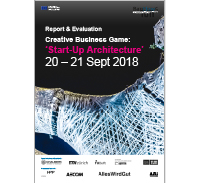Report & Evaluation: Creative Business Game ‘Start-Up Architecture’

The built environment and construction industry represents one of the largest industries in the world. As an asset-heavy and labour-intense industry, it has not embraced innovation potentials of digital technologies. With the growing emphasis on property technologies (proptech) from software development and information technology companies, as well as from consulting and management areas, existing processes and business models in the built environment are transformed.
As a second workshop, a Creative Business Game was conducted, focusing on new entrepreneurial directions for architectural practices and new business models in the AEC industry. In a 2-day interdisciplinary business game with 24 Master’s degree students from architecture, design, management & informatics, questions on future entrepreneurial opportunities were challenged: Can architects transform their potentials into new competitive advantages in the future? What processes in the design and planning practice need to be changed? How will a new architectural office be organised by integrating new digital technologies? How will the built environment and industry be disrupted by advances in virtual and augmented realities as well as the application of artificial intelligence? How would a team of architectural and management students start up architecture?
6 teams consisting of architectural and management students worked on “Start-Up Architecture” and how digitisation may lead to new business models or disruption. The workshop was supported by the international architectural practices of HPP Architekten, AECOM Design&Consulting and AllesWirdGut, which posed three different business challenges for the teams to respond to.
HPP Architekten gave an introduction and foresight of what topics medium-sized and large architectural practices will face in the future. The company raised the question of what future practices of architects will need in their organisation, design and planning processes to remain competitive. The second challenge was described by AECOM Design&Consulting as a fictitious case, in which the teams were asked to act as a property manager for a company, and create a new value for its real estate beyond known co-working ideas. The third task considered architecture as a product and called for ideas to redefine architectural services in scalable ways. In addition to the presented tasks, two successful start-ups originating from TUM Department of Architecture / TUM - KEWAZO.com and flissade.com - provided insights into their way of developing ideas towards market implementation.
In contrast to the structured design sprint conducted as a first workshop, in the creative business game only a few design tools were provided. The 24 participants from architecture and management studies assembled in 6 teams of 4:
39% female / 61% male
96% master degree / 4% others
82% TUM student / 18% incomings
The teams worked independently according to a rough agenda on two days from 9 a.m. to 7 p.m. with limited facilitation:
Day 1 // Context & Challenge
Day 2 // Model & Pitch
The event was part of the 3-year Erasmus+ Strategic Partnership “Strengthening Architecture and the Built Environment Research” (SABRE), a collaboration of the BauHow5 alliance, the partnership of five leading European research intense universities in architecture and the built environment (UCL, TU Delft, Chalmers, ETHZ, TU Munich). SABRE is co-funded by the Erasmus+ programme of the European Union.
Report & Evaluation: Creative Business Game ‘Start-Up Architecture’
Editors: Christos Chantzaras, Martin Luce, Yolande Schneider
Publisher: Technische Universität München, Fakultät für Architektur
ISBN: 978-3-948278-15-1